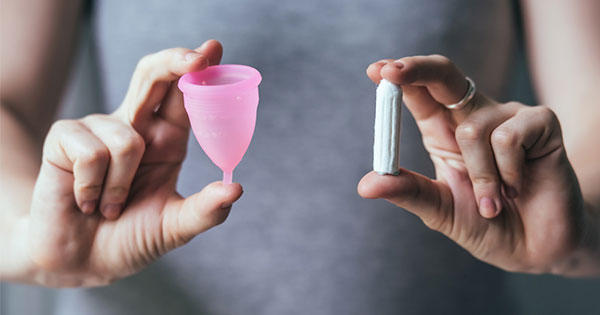Menstruation is a normal part of every woman’s life and there are different sanitary wear available to contain the flow. But how informed are women on the implications of their choice of sanitary wear?
When a girl approaches puberty, she usually gets a talk on what to do, products to buy and how to maintain her hygiene when her menstrual cycle begins. Most times depending on who gives this talk the girl will end up using sanitary pads or napkins, tampons or menstrual cups. The advantages and disadvantages of each may not be presented to her as the mother, sister or guardian will most likely just tell her what has worked for her personally. The young girl simply adopts the method and in turn passes it down. It is only a few who experiment to make their own choices.
There are different types of sanitary wear; sanitary pads/napkins, tampons and menstrual cups. Each of these has its strong point and down side as presented below.
SANITARY PADS/NAPKINS
There are basically two types of napkins or pads, they are cloth pads and disposable pads. Cloth pads can be washed and reused. Disposable pads should be disposed after each use as the name implies. For obvious reason, most people usually go with the disposable pads.
Some of the advantages of using pads are:
• They don’t increase menstrual cramps.
• They can be worn overnight.
• They are easier to use than tampons.
• If you prefer external products, pads is the way to go.
• It works best if you are trying to monitor your flow.
• They have fewer health risks than tampons.
Some disadvantages of the pad are:
• Sanitary pads can be uncomfortable.
• With disposable pads there is a risk of infection.
• They create more waste.
• When using a sanitary pad, you can’t go swimming.
• Disposable pads can also create body odour.
TAMPON
Tampons are a small plug of soft material inserted into the vagina to absorb the menstrual blood. They are difficult or impossible for those with untreated vaginismus (a condition that affects a woman’s ability to engage in vaginal penetration including sexual intercourse, manual penetration insertion of tampons or menstrual cups), or an untreated imperforate hymen to use. This is a congenital disorder where the hymen without an opening completely obstructs the vagina. Barring the above conditions, a young lady who is a virgin may be reluctant to use a tampon as it will perforate the hymen. Tampons also have their advantages as well as disadvantages.
The advantages include:
• Easier to carry around in a bag.
• Does not show through clothing.
• No bulky pads or liners to deal with.
• Is inserted inside so body odor during use is not an issue.
• With it you can go swimming.
• It is internal so there is no mess from blood.
• Holds more fluid than pads especially if you use the highest grade ones.
The disadvantages include:
• It can increase menstrual cramps.
• There is an increased risk of vaginal infections.
• It can be inconvenient due to precautions.
• It can lead to TSS (Toxic Shock Syndrome).
• It is uncomfortable to use.
• It cannot be used with light flow or no flow.
• It cannot be used by someone treating infection.
• It may leak without any warning.
Read also: Tuberculosis silently killing Nigerians
MENSTRUAL CUPS
This is a feminine hygiene product that is inserted into the vagina during menstruation. They are usually made from flexible medical grade silicone and shaped like a bell with a stem. The stem is used for insertion and removal. The bell shaped cup seals against the vaginal wall just below the cervix. They can be changed every 4-12 hours depending on the flow of the user. The cup is removed, emptied, rinsed and reinserted. This product is not very popular in Nigeria. Unlike tampons and pads, the cup collects fluid rather than absorbing it. Some of the advantages of the menstrual cups are:
• There is no odor during use as the blood is not exposed to air as it is with pads and tampons.
• The vaginal pH and beneficial bacteria stay in place.
• There is more time in between changes.
• The menstrual cup is safer and keeps you away from infections more than the other two methods. This is so because of the material used in making it.
• Sexual intercourse is possible even with the cup in place.
Its disadvantages include:
• It’s main disadvantage is the mess that is likely to happen during changes. It is hard to use especially when out in public.
• It is difficult to insert in for some people.
• There is usually a cup removal issue.
• Maintaining the cup is cumbersome as it needs to be sterilized after each cycle.
• There is also a problem with the fit as anatomies are different.
Throwing more light on sanitary wear, Dr. Vitalis Etim, Gynaecologist said; “Medically we advice against the use of tampons. Nothing is supposed to be inserted into the vagina. When you introduce something inside, you disrupt the normal flora of the vagina. The normal flora is there to guard against infections and the tampon gives room for external infection to the internal environment. We advocate solely on the use of sanitary napkins as they are safe and do not have the above problem.”
Generally, whatever method you want to go with still remains a personal choice. What works for A may not necessarily work for B. If you experience too much of an issue with any method, it is advisable to talk to a doctor to find out what is best for you.











